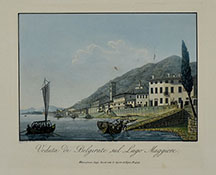Dresden 1784 - Milan 1837
Caroline von Schlieben and Friedrich Lohse began dating during their artistic apprenticeship in Dresden. When they married, he had already been in Paris for some time, to perfect his artistic training. And from Paris they left in 1805, following the viceroy of the Kingdom of Italy, Eugenio Beauharnais, for Milan. After the fall of Napoleon and the decline of the Kingdom of Italy in 1814, the couple decided to settle permanently in Milan, dedicating themselves to drawing and engraving Lombardy urban and landscape views in their house on the Naviglio in contrada S. Damiano 299. Thus they became Federico and Carolina Lose, he a draftsman, she an engraver and colorist of his views, two artists who translated the romantic vision of nature, assimilated in their youth from the pages of Rousseau, into the representation of the landscape. After the fall of Napoleon and the decline of the Kingdom of Italy in 1814, the couple decided to settle permanently in Milan, dedicating themselves to drawing and engraving Lombardy urban and landscape views in their house on the Naviglio in Contrada S. Damiano 299. Thus they became Federico and Carolina Lose, he a draftsman, she an engraver and colorist of his views, two artists who translated the romantic vision of nature, assimilated in their youth from the pages of Rousseau, into the representation of the landscape. At the beginning of 1816, the first aquatints drawn by Federico Lose and engraved by Carolina Lose began to appear in the volumes of the album "Le bellezze pittoriche di Milano", published by Ferdinando Artarìa between 1815 and 1821, and in the "Viaggio pittorico e storico ai tre laghi Maggiore, di Lugano e Como", published by Francesco Bernucca between 1816 and 1821, where they signed 26 of the 56 views in the album.
But it was in 1823 that the couple came to the attention of publishers and print collectors with the "Viaggio pittorico nei Monti di Brianza", a splendid album of 24 hand-colored engravings, of which they were also the publishers before selling the re-edition rights to the Bettalli brothers. The following year Federico Lose published an album of 16 aquatints engraved and colored by him, the "Viaggio pittorico e storico al Monte Spluga da Milano a Coira", which is the first illustrated guide to the new tourist itinerary between Lombardy and Europe after the opening of the new Spluga road on the Swiss and Valchiavenna side. After 1824 their activity petered out. Federico Lose died in 1833, followed four years later by his wife with whom he had formed one of the most interesting artistic partnerships in Lombardy during the Restoration.
